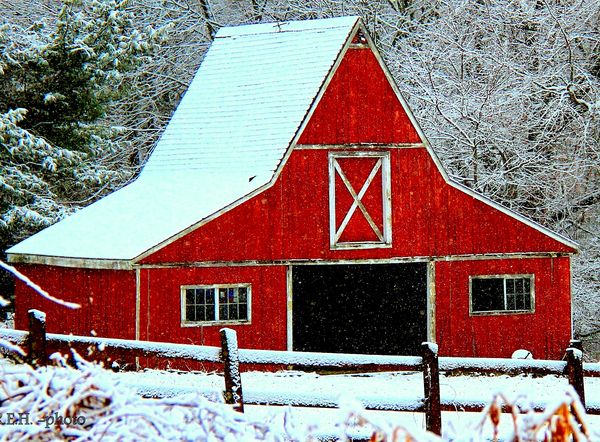What are these white spots?
Nov 14, 2015 13:35:35 #
Basil wrote:
Anyone have any idea what might have caused these random white dots?
They are white, so there is light on whatever it is. They are out of focus, so they are not within the DOF.
Bugs or dust in the air.
If are out on a day when it is snowing you can get that effect with a lot more drama by taking a picture of somebody about 10 or 15 feet away, using a fast lens wide open. And you can make it really dramatic by taking the shot at night or in low light using a flash. Every snowflake that isn't close to the point focused on will be a "white out of focus spot".
Nov 14, 2015 13:49:56 #
Apaflo wrote:
They are white, so there is light on whatever it i... (show quote)
Here is what snow looks like
Nov 14, 2015 13:56:12 #
JD750 wrote:
He has said the problem happens only with that one lens.
Yes, again, different lenses may make them look more or less prominent. If you shoot into a dead black background it may make it easier to define them.
Nov 14, 2015 17:15:23 #
Rongnongno wrote:
Since they are not in the same position you can eliminate:
- sensor
- 'stars'
- anything slow moving
You are left with a few choices:
- seeds
- insects
- spiders
I had a similar problem in the spring. The best bet was insects.
- sensor
- 'stars'
- anything slow moving
You are left with a few choices:
- seeds
- insects
- spiders
I had a similar problem in the spring. The best bet was insects.
You cannot eliminate stars. The camera is pointed at a different part of the sky for each shot. That is why stars are quite likely.
Nov 14, 2015 17:17:11 #
Apaflo wrote:
They are white, so there is light on whatever it i... (show quote)
Dust in the air is indeed another viable cause. Have you ever noticed them in the spotlight beams on shows like The Voice?
Nov 15, 2015 07:21:25 #
It looks like dust on the sensor. It might not show up on the zoom lens because they were "cropped" out at the greater zoom range. Look again at the zoom lens photos taken at around 300mm.
Nov 15, 2015 10:05:37 #
MtnMan wrote:
You cannot eliminate stars. The camera is pointed at a different part of the sky for each shot. That is why stars are quite likely.
Stars repeat the same pattern.
No pattern here so no stars.
Nov 15, 2015 10:07:26 #
Rongnongno wrote:
Stars repeat the same pastern.
No pastern here so no stars.
No pastern here so no stars.
Once again the camera is not pointed at the same section of sky. There is no pattern. Thus likely stars.
Nov 15, 2015 10:08:56 #
MtnMan wrote:
Once again the camera is not pointed at the same section of sky. There is no pattern. Thus likely stars.
Say anything you want stars no not behave this way. Ask any photographer dealing with astrophography.
Nov 15, 2015 10:08:57 #
Howard5252 wrote:
It looks like dust on the sensor. It might not show up on the zoom lens because they were "cropped" out at the greater zoom range. Look again at the zoom lens photos taken at around 300mm.
Don't think so now. I think the idea of insects or seeds floating is more likely given the very random pattern. Also, I took a picture of white poster board at f22 in good light and see no evidence of dust. Now that I think about it, this was a wetlands area with lots of flying insects, so that is most likely what I'm seeing.
Nov 15, 2015 10:35:52 #
MtnMan wrote:
Once again the camera is not pointed at the same section of sky. There is no pattern. Thus likely stars.
You are manufacturing data, not analyzing what the OP presented.
The two images posted were taken only 0.09 seconds apart. They are of virtually the same section of sky, but are not precisely registered with each other. The exact same spots show up in both images, and of course in the exact same pattern.
The shapes of different spots change, and are not necessarily round.
They are not stars. The size and blur is different from one spot to the next, indicating different distances from the camera. They can't be stars.
Nov 15, 2015 10:38:26 #
Apaflo wrote:
You are manufacturing data, not analyzing what the... (show quote)
Ah, that's the kind of analysis needed!
Leaning towards the bug theory now.
Nov 15, 2015 10:38:51 #
Apaflo wrote:
You are manufacturing data, not analyzing what the... (show quote)
I think those who suggest insects are probably right. In other photos, the dots show up in very different locations.
Nov 18, 2015 20:31:28 #
Nov 18, 2015 20:53:58 #
PixelStan77 wrote:
From my experience it is caused by dirt on your sensor.
I think I have concluded, if you look at past replies, that it was most likely insects in the FOV.
If you want to reply, then register here. Registration is free and your account is created instantly, so you can post right away.







